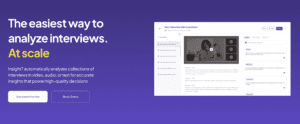
Transcription services are crucial for professionals looking to convert interview recordings into structured, searchable text. They do more than just transcribe words; they help extract insights and identify key themes, making data actionable. Whether for qualitative research or business intelligence, interview transcription services like Insight7 can spotlight pain points, desires, and behaviors, enhancing the value of your interviews.
Understanding the Transcription Process
To transform interview recordings into usable text efficiently, it’s essential to understand the transcription process. This starts with choosing the right tools like Otter.ai, Rev, Sonix, and Insight7, which offer varying levels of precision and features like speaker identification and time-stamping. Integrating these services into your workflow ensures seamless transcription from platforms like Zoom or Google Meet. Prioritizing efficiency and accuracy avoids pitfalls like time-consuming manual transcription and data inconsistencies.
Benefits of Interview Transcription
Transcribing interviews captures every detail, turning spoken words into a clear, searchable record. Key benefits include:
- Accuracy and Clarity: Ensures information is accurately captured without relying on memory.
- Efficiency in Analysis: Makes analyzing content easier, helping to identify patterns and themes swiftly.
- Accessibility and Inclusivity: Makes content accessible to those who are deaf or prefer reading.
- Documentation and Compliance: Provides a textual record for compliance and accountability.
Tools like Insight7 offer quick transcription with added functionalities like speaker identification and insight extraction, making data interpretation faster and more meaningful.
The Transcription Process
Transcribing involves several steps, starting with uploading the audio file to a transcription platform like Insight7. Advanced AI tools transcribe the content accurately, and the text is then refined to correct discrepancies. This process creates a structured document that reveals patterns in customer pain points, desires, and behaviors. Customizing transcription settings can highlight specific insights, enhancing decision-making processes.
Choosing the Right Interview Transcription Services
When selecting transcription services, consider accuracy, turnaround time, speaker identification, and analytical features. For example, Insight7 provides tools to analyze transcripts for specific insights, making it valuable for deriving conclusions from interview data. Ensure the service can handle your work volume, supports your audio quality, and integrates seamlessly with your workflow.
Manual vs. Automated Transcription Services
Decide between manual and automated transcription based on accuracy and time efficiency. Manual transcription offers greater detail and accuracy but is time-consuming and expensive. Automated services like Insight7 use AI for quick transcription, although they may struggle with complex terminology. Each has its strengths, and the right choice depends on your project needs.
Key Features in Interview Transcription Services
Look for accuracy, turnaround time, speaker identification, and advanced data analysis capabilities. Accurate transcriptions capture nuances and details, while quick turnaround times meet tight schedules. Effective speaker identification clarifies conversations with multiple participants. Advanced data analysis extracts key insights, transforming raw transcripts into rich summaries.
Conclusion
Transcription services turn recorded interviews into valuable, text-based documents, streamlining qualitative data analysis. They improve accessibility, manageability, and help pinpoint valuable data quickly. Using services like Insight7 provides a significant advantage in deriving meaningful conclusions.
Get started for free or Book a demo today and transform your interview recordings into actionable insights.



